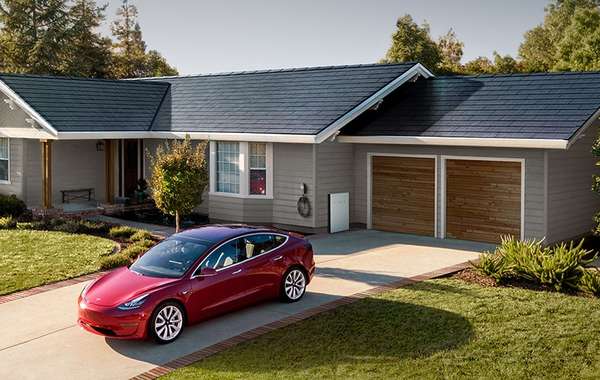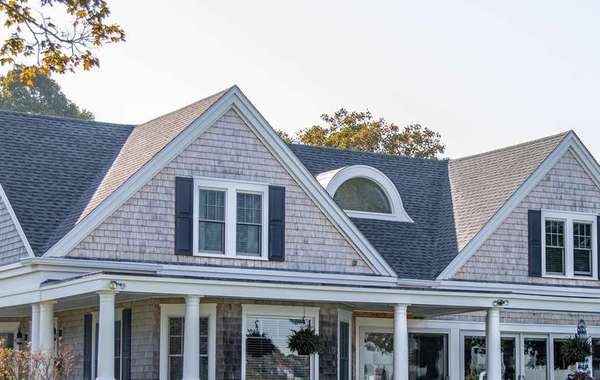Rooftop solar-power production is fairly commonplace now, and you always know exactly which roof has them because they are highly-visible and somewhat clunky looking. They aren’t ugly but, they aren’t really beautiful either.
As a follow-up to our original article on the Tesla solar roof here, the next phase of solar-power generation for homes are solar shingles, solar tiles or what has become known as Solar Roofs. Simply with the mention of that, it is likely that at least a few of you instantly thought of the Tesla Solar Roof. Good on ya, or good on Elon Musk I guess, for getting in your head. However, what many don't realize is that Tesla is not the only solar shingle manufacturer, but they are certainly the most well known - and the buzz that surrounds any business activity with the name "Tesla" attached to it is certainly making waves in the home solar industry.
What are building-integrated photovoltaics (BIPV)?
Standard photovoltaic solar panels are typically large panels that protrude from roofs by several inches. Contrary to that, the low-profile rooftop solar roof option, which is also known as BIPV (building-integrated photovoltaics), are solar shingles or tiles that are installed directly onto roof sheathing in areas of high solar exposure, and are used in conjunction with conventional roofing materials such as asphalt shingles or metal in areas of low solar exposure. An instant advantage with BIPV over existing rooftop solar panels, is that you don’t need to remove roof coverings in order to replace them, since BIPVs themselves offer weather proofing. That alone is a significant improvement over PV panels that always have a tendency to look like an add-on.

Price comparison between solar panels and solar shingles or solar roofs
Trying to compare the prices of rooftop solar panels to BIPV solar roofs is a bit of an exercise in futility due to a significant number of variables that would need to be considered. The biggest one being, that to mount standard solar panels on a roof, you need to cover that roof in the first place. Solar shingles are in themselves a weather protective solar roof cover AND a power-generating solar panel.
The average per-watt price for an old-school rooftop solar installation currently (Feb 2020) ranges between $2.57 and $3.35 USD, and the average total price for a full solar panel setup in the US averages between $11,411 and $14,874 after any regional solar-tax credits are applied. Again, that’s an average; incentives vary, and not all states (or Canadian provinces) will have tax incentives and rebate programs. (Keep in mind that even when not indicated, all prices listed here are in US dollars.)
The above may seem a lower price than a full solar roof installation, until of course you add the cost of a roof covering, and possibly having to remove panels in fine working order simply to replace defective shingles beneath them. And, to add additional types of apples to compare with these oranges - you also have aesthetics, durability and home resale value to consider.
Most roof-mounted solar panels (when properly installed) are rated to withstand as much as 140 mile per hour winds, which is great, and is even a bit higher than the Telsa solar roof. But, the asphalt shingles beneath and around those panels can often only handle 90 mile per hour winds, which means you may have to remove the panels to do roof repairs. So… how do you like your apples and oranges so far?
Where BIPV solar roofs really pull away from solar panels is the lack of hassle with roof coverings, and the cool factor. They just look cooler, full stop. And we are probably all attracted to ‘shiny things’ a bit more than we may like to think. : )
Solar roofs & solar shingles that aren’t from Tesla
Solar shingles have been around for a while, but none of them ever really secured a stronghold in the Solar Roof industry, nor did they get much media attention prior to the arrival of the Telsa solar roof, but kudos to the pioneers of the industry. There are several manufacturers of BIPV shingles, Tesla of course being one of them, but let’s start with the others. You will notice that they are all fairly close in characteristics, performance, price and warranty, but there's one inescapable difference... read on:
Dow Powerhouse solar shingles in review:

After a short stint in the market, Dow Chemical Powerhouse shingles folded up their tent, but made a recent comeback under a new license holder; RGS Energy. The Dow Powerhouse design was a thin-film copper indium gallium selenide (CIGS), but the new 3.0 version uses silicon cells instead.
The shingles are offered in a 55 Watt version at 15.6% efficiency, and a 60 Watt version at 17.1% efficiency. Dow shingles did recently receive some industry accolades, as they were named the “best energy-efficient product” at the 2019 International Builders Show in Las Vegas so this appears to be a viable solar roof option.
Costs & warranty comparison for Dow Powerhouse solar shingles
- Install price: $3.89 per Watt
- Product warranty: 11 years.
- Weather-performance warranty: 25 years.
Certainteed Apollo solar shingles in review:

Certainteed solar roof shingles are installed directly onto roof sheathing with standard deck screws. Fasteners are covered by the subsequent solar shingle, just like asphalt shingles.
14 high-efficiency monocrystalline silicon solar cells provide a power rating of 63 watts per solar shingle with a conversion-efficiency rating between 14.7% and 15.3%.
Costs & Warranty comparison for Certainteed Apollo solar shingles
- Install price: $4.90 per Watt
- Installation and workmanship warranty: 25 years.
- Power output warranty: 25 years.
- Inverter and other components: 10 years.
- 110 mile per hour wind warranty: 10 years.
SunTegra solar shingles in review:

According to SunTegra’s product specs, their solar shingle system has a conversion efficiency rate between 14.4% and 15.9%.
SunTegra shingles contain 16 solar cells each and offer 64 to 67 Watts of power output. Like other BIPV shingles, SunTegra mounts directly to roof decks and acts as the roof covering.
Costs & Warranty comparison for SunTegra solar shingles
- Install price: SunTegra doesn’t list the cost on their website, but numbers circulating around the web indicate $3.65 per Watt.
- Product warranty: 10 years.
- Power output warranty: 25 years.
So is Tesla the best solar roof?
Most manufacturers of solar shingles operate in the same general way – they mount directly to roof sheathing for a low-profile and reasonably seamless look, and they kind of integrate with existing roofing materials. The prices vary between manufacturers, as do the warranties, but yes, we have a favorite. None of these solar roof competitors listed above compare to the Tesla warranty or appearance. A Tesla Solar Roof is at first view the most expensive solar roof option, but again, you’re talking apples and oranges.
What makes the Tesla solar roof different?
Solar shingles (or traditional solar panels) on an un-shaded south-facing shed roof will capture solar radiation the whole time the sun is up. But, most houses aren’t built like that; there are various roof styles with north-facing pitches that collectively mean perhaps as much as 70% of a roof surface will never see the (sun)light of day, so putting solar panels on them would be a waste of time, money and resources. This is where Tesla starts to stands out from the pack in a detailed comparison.
Tesla has developed an integrated active / inactive roof-tile system, so you don’t end up paying for solar panels that won’t generate power, and you don’t have visible junctions between active and inactive shingles and tiles. The other providers listed above also provide active and inactive components, but you know exactly which are which because they look so very different - and as a home is typically the most expensive purchase and investment we will make, we tend to be quite fussy about the aesthetics.

That means that, aesthetically speaking, Tesla is the clear front-runner, and aesthetics are very important to designers, architects, homebuilders and homebuyers.
The new version of Tesla solar shingles is in the news because they have reduced the cost of installation and are ramping up production of the V3 Tesla solar roof to install 1000 per week by 2021. The newest patented version is a larger-sized PV solar shingle made by assembling smaller solar tiles which will reduce the installation time. They have also reduced the amount of connection points, which also speeds installation; that equates to savings in labor and a lowered price from their original offering. These design modifications likely contribute to the longer warranty and projected product lifespan, which is said to be 30 to 50 years. Faster install, more durable, longer life… see where this is going? Mass-market, that's where...
Tesla has been around long enough now for a pattern of behavior to emerge, and the solar roof seems no different. To use the Tesla EVs as an example; rather than first releasing a low-priced electric commuter vehicle, Tesla released the sleek eye-catching sports car that few among us could afford. All we could do was salivate and wait for the next one. So, when they finally released the Model 3 for the masses, Tesla was already a household name and we lined up like black-Friday shoppers for the chance to get one. And now, Model 3s are everywhere, and the new buzz is now about the "affordable" version of the SUV Model X, the new Model Y - the electric SUV for the masses... not to mention the Cybertruck of course which was designed from it's unique exoskeleton up to be affordable.
So back to the Tesla solar roof in detail - this is the 3rd version of the Tesla solar roof shingles or more accurately tiles, and the price point they have provided - when you consider the lifespan and power they produce - means this could be a more-affordable roof covering than the cheapest asphalt shingles on the market. And WE think THAT is great news. This is not to say that their competitors can’t also claim to be ‘cheaper than shingles’ in the long run when energy generation is considered, but no one can touch Telsa so far in terms of aesthetics, longevity, and frankly, the ‘wow’ factor.
Costs & Warranty comparison for the Tesla Solar Roof tiles
- Install price: Tesla claims $1.99 per Watt ( we hope that will come to fruition and remain cautiously optimistic)
- Product warranty: 30 years.
- Power output warranty: 30 years.
- 130 mile per-hour wind warranty: 30 years.
Ecohome predictions for the BIPV market
One very legitimate criticism of all Tesla products so far is the meeting of their own delivery-target dates. The Tesla solar roof is no different. Their competitors have a long head-start in the industry, but once a good number of Tesla roofs are installed in Canada and the US, and consumers get a look at them compared to the competition, we think it will be game over. And did you notice the warranty timelines? 30 years across the board is a noticeable improvement (and indication of confidence) over combo 10 to 25 year warranties for different components from the Tesla solar roof competitors.
And this all begs the question - if they really do become the most sought-after roof, will they then be able to meet demand? Well, there is a Tesla masterplan for that too. Since as much as 70% of a roof won’t need active solar panels, it makes no sense to tie up Tesla production facilities with producing inactive but matching roof tiles, so they will probably license that out to mainstream roof tile manufacturers instead. And, considering it is 70% of the roof surface, and it's going to be in the premium roof covering market sector - and it has that magic "Tesla" name attached to it - which roofing product manufacturer wouldn't be interested in producing the inert Tesla solar roof tiles?
In our opinion, all solar roof competitors will have no option but to follow suit and offer a full-roof solution PDQ, and why they haven’t thought of this yet is a mystery to us. When they finally take notice that Tesla is eating their lunch, it may well be too late to do much about it, so watch for roofing manufacturers like Certainteed to possibly give up their solar ambitions and get in the back seat of the Tesla and stick to providing the non-active components, or up their offer and also introduce non-active versions of their own solar roof coverings so they can also offer a full solar roof package. That’s just our take anyway, but at the very least, it will be a fun competition to watch as renewable energy takes off with the increase in Zero Net Energy homes being built in the USA & Canada as part of the Green building trends for 2020.
Now you know more about the Tesla Solar Roof, cost, competitors & what our reviewers think, find more info pages about Solar PV & sustainable building in the Ecohome Green Building Guide and these pages here:
Find out here about the benefits of signing up for a free Ecohome Network Membership! |





























Comments (0)
Sign Up to Comment